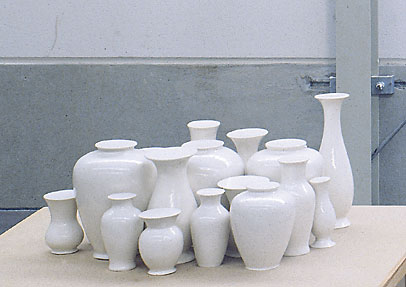|
Dieter Froelich (born
1959) A large number of white porcelain vases are placed on several small
tables: different sizes, various shapes, silky, shiny and reminiscent
of the great Italian still-life painter Gorgio Morandi. The compact ensembles
spontaneously call to mind southern villages or towns. All the vases are
sealed at the top. This transforms the vases into hollow bodies which,
whilst still recognizable as everyday objects, are quite evidently useless.
The porcelain objects, of which there are 21 various types cast from real
vases, point to a long tradition. Vases have been pottered or turned since
ancient times. This is why they have something concentric about them,
something concentrated and directed inwards. They keep to themselves,
are concentrated in themselves. When speaking about vases you refer to
the neck, shoulders, body, belly and feet. They are no ordinary vessels,
but call to mind a woman’s body. In pre-Columbian cultures the vases
even had breasts and arms as handles. As they usually contain flowers,
vases have something luxurious about them—something one thinks about
even when they are sealed. Perhaps they are reminiscent of houses which
together form a village with shady sections, or perhaps a group of women
standing together: Together they form a sculpture composed of a number
of elements which can be moved apart. In so doing the sculpture can be
altered. The white, hollow bodies communicate with one another in that
together they form inner spaces, cast shadows, radiate light. In painting,
a still-life usually consists of various objects, but in Morandi’s
case it is sometimes just bottles. Froelich too, works with this reduction
and creates a great sense of calm with his collection of simple, similar,
concentric objects. There is something of an aura about this self-absorption
of the sculpture. The white gives the impression that what one sees is
just a memory—something that transpüoses it into the realm of
the archaic. The sculptures possess an intrinsic and imobile sense of
seriousness and they are beautiful in a classical sense. The concentric
aspect of the vase bodies underlies their being present in one spot. In
contrast to motion, speed, acceleration or in other words in contrast
to time racing past, but also in contrast to the network of similar places
and their uniformity—both trends that are present in modern society
and its technology, here a place is upheld in discerning modesty. And
this is where the conservative humanity of these works lies. Other works
by Froelich, who was born in 1959, are concerned much more clearly with
everyday life. The artist usually works with kitchen utensils and language.
And he cooks. Speaking and eating, two activities that we conduct using
our tongue. It is a well-known fact that the aesthetic stance known in
German as «Geschmack» (taste, as in good taste), is derived
from «schmecken» (to taste). Burkhard Brunn
|
